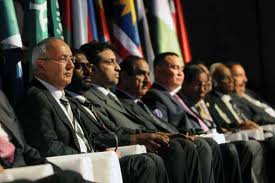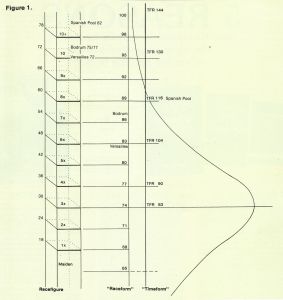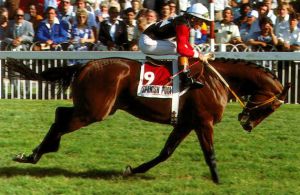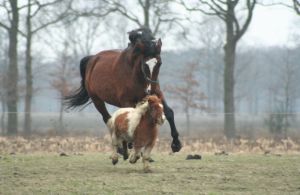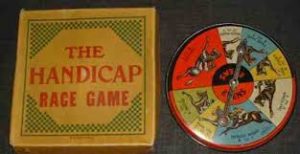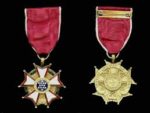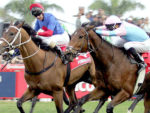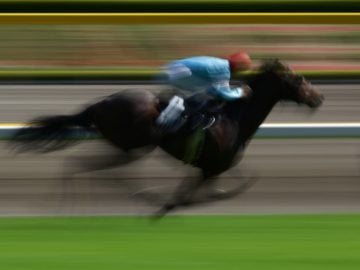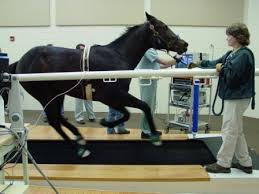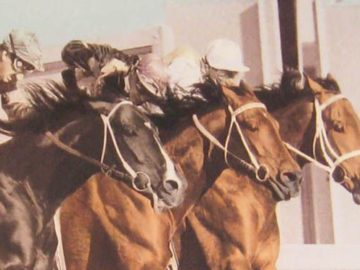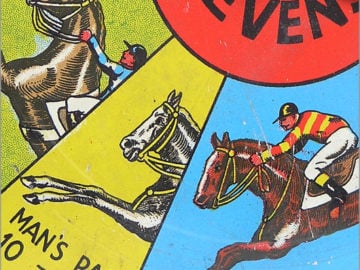Speak to a person about handicapping, and you invariably get the impression that what counts in setting weights is the number of wins horses have had – and to hell with ability, or that funny thing called Weight-for-Age. A 4-time winner gets weight from a 7-time winner in a handicap, and that’s that. The cumulative effect of years of exposure to set-weight racing and racefigure-handicaps seem to have taken care of whatever creative thinking there was in South African racing and breeding circles.
The last public occasion on which some sensible words (and also less sensible words) were spoken on handicapping, was in 1973 (!), at a conference on programming and handicapping, called by the Owners and Trainers Association of Southern Africa. Topics discussed included whether major feature races should be handicaps or conditions races, and whether set-weight racing should replace handicaps for up to 7-time winners. The conference was purely a forum, an exchange of ideas, and no recommendations were made: it was left to the Race Clubs in South Africa to decide whether to follow or implement any of the ideas arrived at. One needn’t have been clairvoyant to have predicted that no action would be taken, and that the basis on which programming in the various centres is conducted would be as unimaginative now as it was then.
But things are about to change, or so it seems. Quite independently from each other the two Cape clubs have decided to implement Racefigures in the Cape, although the basis on which, and when, are not clear. This means that all three major centres (Transvaal, Cape, Natal) will make use of Racefigures in the near future, though not necessarily in the same way (!). Let us look at what they are and how they work.
The earlier mentioned Conference on Handicapping defined the Racefigure indicator as, quote, “a very convenient way of expressing the stage of progress that a horses racing performance suggests that it has reached. It does not indicate either a horses ability or its potential. Accordingly its use is not desirable in determining the weights for major features.” End of quote.
The Racefigure allocated to a horse is increased as the horse wins races. Racefigures are then used to frame weights for races where horses with different Racefigures meet. Every point on the Racefigure scale is supposed to represent half a kilo. In the Cape, where set-weight racing really is not more than a variation on the Racefigure-theme, there is a standard penalty of 3 kilos for a win. In Natal the Racefigure of a horse can be adjusted in any way the handicapper sees fit (even if it doesn’t win, but runs second), both upwards and downwards. In practice this adjustment usually amounts to about 6 points for a win, especially for the first few wins, so that Natal Racefigures and the Cape’s Progress levels amount to virtually the same thing. No account is taken of the Weight-for-Age differences for horses of different ages. For races of 2400m and over, the Cape reduces its penalty to 2kg per win; in Natal the picture is less clear, although it appears that for races over ground 1 point counts for less than half a kilo (the Natal handicapper plays around with the figures in all Racefigure-races, so that it is hard to say what counts for what and when). In the Transvaal things are simple and straightforward: once the handicapper has adjusted the Racefigure, every point counts as half a kilo, without exception – Weight-for-Age or the distance of the race is disregarded. As they say in the Transvaal “Its up to the trainer to run his horses over the right distance and to place his horses in the right company”. Whatever that may mean.
So what effect do Racefigures have?
First and foremost they ensure that the better horses win more races. Horses win progressively until their level of competition catches up with them and they reach a platform. “Platformed” horses only win races when things go right for them, usually against other horses in similar circumstances; as long as they find themselves in the company of horses of the same age that have not yet reached their respective platforms they will be (in theory) unable to win. Woe betide the platformed horse that wins a race run at false pace (or similar misfortune) – it is almost certain never to win another race again.
Racefigure progress made by horses has been illustrated in Figure 1. Each of the boxes represents 6 Racefigure points, or on average 3 kilos (1 point counting for half a kilo). Maiden fillies start off at a Racefigure of 15, maiden colts and geldings at 18. With the usual penalty early on at 6 points, one time winners generally have a Racefigure around 24 (colts and geldings, on which we will concentrate for convenience). The illustrated boxes can therefore be seen as boxes containing horses (generally) with the same number of wins. You win a race, you jump a box, that’s the principle. Some examples have been given, shown next to the boxes.
Two major questions come to mind. Firstly the penalty of 6 points per win – is it a fair one and what are the effects? And secondly, is the difference of 3 points between the sexes correct?
To answer the first question a scale has been drawn next to the boxes, showing the progress in kilos from box to box. Next to that two other scales appear. The first one is the scale on which Timeform in England rates its horses. Of course, they do not work in kilos but in pounds (0.4536 kilos), so that the scale was converted to fit. The second one is the scale used by Raceform (Cape and Natal horses), which uses kilos. Next to that is drawn a normal-curve (but turned on its side), to statistically show where the majority of horses are.
The problem was to fit all of them on the same scale. Timeform’s average rating is 83 pounds, with a rating of 144 representing the absolute top rated horses. Raceform’s average is 74 kilos, with the best horses in South Africa reaching about 90. On the assumption that the average horse in South Africa in terms of ability rates about a two-time winner, the average ratings of Timeform and Raceform, and the centre of the bulge of the Normal-curve have been set at the top of the 2-time winners box. That assumption means that up to 60% of horses racing ever wins a race, but note that it is also related to the number of opportunities for maidens to win races in relation to the total number of maidens racing – too few races for too many maidens will make few maidens win, and vice versa. If you feel the average line is not drawn right, adjust it to your taste and note what happens to the following argument.
Note also that to assume that the average horse in Britain (Timeform) and the average horse in South Africa (Raceform) can be rated as having the same ability is entirely fair; there is enough evidence based on Timeform rated horses racing in South Africa to prove that (Foveros, Spanish Pool, Boezinge, Rizla Blue, etc).
Now the fun starts.
It appears that the Racefigure scale is majestically out of proportion. Take a horse like Spanish Pool, who had a Racefigure of 82 during last years Natal season. A glance at the scale shows that this compares with a Timeform rating of about 140, higher than the Guineas and Derby winner in the UK in 1984 by about 5 pounds. Before he came to South Africa, Spanish Pool was rated 24 pounds lower at 116 by Timeform, comparable to 89 on the Raceform scale, in other words more or less his SA-form.
Bodrum (Racefigure 77) and Versailles (Racefigure 74) achieve a comparable rating on the Timeform scale close to and a little behind the UK-Guineas and Derby winners, and in kilos between 6 and 10 kilos ahead of the best in an average year on the Raceform scale.
There can be little doubt that Racefigures and handicap ratings, based on a statistically reliable method, are two totally different things. And the practice of calling Racefigure races “handicap” races is misleading to say the least. In Natal they even have unraced 2yos running in a handicap!
The problem appears to lie in the amount of the penalty given. If the average 6 point penalty was progressively reduced as more races are won (and especially over ground), the Racefigure scale would stand a much better chance of fitting the proper long handicap scale.
What then can be the purpose of Racefigures as currently in use, and how should they relate to handicapping proper?
Given the limitations of handicapping horses of modest ability (they are generally inconsistent, for whatever reason), the Racefigure method is an excellent way of avoiding arguments about the handicappers impressions and those of the connections, and taken a step further, in avoiding malpractice. The virtually standard penalty imposed for the first few wins ensures that the better horses are quickly separated from the averages ones. It starts when horses are 2yos. Juvenile races are generally won by horses which are above average, to leave the lesser lights as maidens until they are 3yos. The competition for early 3yos is still pretty stiff; generally Raceform ratings of 3yo winners early in the season are not lower than 72, while this figure drops as the season progresses (the better ones move on) – by season-end a horse rated between 60 and 70 is quite capable of winning a maiden. So far so good, and Racefigures prove their worth by separating wheat from chaff.
But for early 3yos something else happens: they race, for the first time, against older horses. Considering that the (unofficial) Weight-for-Age difference between 3yos and older horses is at least 5 kilos over sprints, and from 7 kilos upwards over a mile and more, it is surprising that early in the season trainers elect to race their 3yos against older horses at all in “Racefigure handicaps”, especially over a bit of ground. Take a look again at Figure 1. An above average 3yo with 3 wins to his credit finds himself in the 3-time winner box, with a rating of between 74 and 77 kilos in the Raceform long handicap. And having to give between 6 and 9 kilos to an older horse just below maiden winning standard in a race over 1600m. Now add 6 kilos for Weight-for-Age difference and you see that the younger horses ability has to be between 80 and 83 on the Raceform scale, to be on par with the older maiden. Put in other words: it would take a horse of the calibre of Guineas winner Sea Warrior to beat that maiden!
When 5yo Greenhouse (a two-time winner) beat 3yo Royal Yacht (a two-time winner) over 1600m at Scottsville on September 7th last year, their respective starting prices were 10/1 and 7/10, with Royal Yacht giving Greenhouse 1.5 kilos. Most people clearly regarded a good horse like Royal Yacht thrown in at the weights. Both horses ran more or less up to form and there was only a shorthead in it, which proves that the weight difference was fine – only no one understood it. Some reflection on the confusion created by Racefigure “handicaps”! No doubt this coming spring equally good value will once again be had by the sensible few.
The conclusion to draw from this is that even good 3yos will be hampered in their progress during the first part of the season. Even though they are better horses, they generally do not resume their winning ways until Weight-for-Age differences have started to level out somewhat. Or alternatively, if they can be raced only within their own agegroup. But even then only the really good horses win races regularly, while the severity of the penalty for winning (3 kilos) makes it increasingly difficult for them to do so.
Racefigures in fact create artificial barriers. The shape of the curve in Figure 1 shows where the majority of horses can be found. The more horses, the more difficult to win. But at a higher level (and provided the horse has not yet reached its platform) it suddenly finds fewer competitors and better opportunities to win again. Which is why most horses which are above average may take some time to get, say, their third win, before quickly scoring their fourth and even a fifth. Many a time the press will label such a horse as “vastly improved”, while nothing is further from the truth. Circumstances prevented the horse from winning earlier, not his ability, which had been there all the time. It is often the ability of the trainer to choose his opposition that makes a horse reach its ability-platform quickly. As a reward for that, he gets stuck at that platform, with very little real opportunity to win again, given the current programming methods in South Africa.
Racefigures then, are an ideal way to help the best horses win a few races quickly, as (and everybody will agree) they are entitled to. What Racefigures cannot do is create real opportunities for platformed horses, or worse, those horses which are at too high a platform because of a fluke win. This is where we need the handicapper’s expertise to create proper handicaps. He should have little trouble to do that, without much chance of trainers pulling the wool over his eyes – most horses that have won a few races are well exposed by any means. Admittedly some attempt to adjust levels is found with Racefigures too, where horses are dropped on the scale when they fail to run places. But not only does that take a long time for the horse to reach a competitive figure again, the practice of never dropping horse below the figure at which he last won makes this method less than effective.
The ideal combination would be one of Racefigures for lower class horses, up to a maximum of 4 or 5 wins, and real handicaps after that, taking full account of Weight-for-Age and not necessarily related to the previous Racefigure. There should be an overlap between the two, not a division, so that a trainer can test the water, and decide whether he has a better chance of winning in the one or the other, provided his horse is a 4 or 5-time winner (the previously mentioned Conference on Handicapping discussed a division to be set at 7-time winners – Figure 1 and its scale clearly show that would be too high a level). For platformed horses that are 2, 3 or 4 time winners proper handicaps should also be programmed; this would serve horses 4 and older to at least on occasion be able to resume their winning ways. Similarly, conditions races should be programmed for horses with more than 4 or 5 wins, to allow the better horses to win again (which would not necessarily be the case in handicaps proper). Furthermore, handicaps should not be divided in “open” handicaps, A, B and C division handicaps. Official handicappers should have the freedom to select fields in accordance with the horse population in a centre at a given time. Only on that basis can they creatively devise programs together with the programming committees, rather than sort of follow “what we did the previous year”. Circumstances do have a habit of changing, even in racing!
Figure 2 (below) shows how Racefigures and handicaps could be used in conjunction. It should give owners and trainers the opportunity to run regularly with at least the hope of a place (provided they know their horses and can evaluate the opposition), and give the public some variety in their racing fare, with the best possible fields (which would take automatic care of the Clubs turnover). Racefigures by themselves aren’t the answer. Nor are handicaps. A creatively constructed combination of both would greatly benefit everyone. It will take some skill, a lot of hard work and most probably computer assistance to achieve it. Some mistakes will be made, that’s certain. On the other hand, can we afford to be complacent about our future?
Figure 2 – The balanced programming diet
1. Weight-for-Age races; objective: to determine the best of one generation and across generations; to be run regularly throughout the year, preferably at times when horses from all centres are likely to come together. Prize money for these races should exceed prize money for any of the categories below – the best deserve the best.
2. Conditions races; objective: to ensure that the better horses have the opportunity to win the most money; weights to be carried are set at a certain level, with penalties for one or a combination of previous wins, previous earnings, sex, breeding, or any other condition which does not solely relate to the actual ability (including WFA differences0 of horses competing; these should be the majority of races, providing bread and butter racing; they should be available for all horses, right throughout their career, but with a concentration on horses with fewest or no wins (because there are more of those). This category includes the use of racefigures; but once racefigures are set, they must be adhered to; handicappers should not be allowed to tamper with them as they see fit when entries are made; fixed difference per point Racefigure should be set as part of the condition of the race (probably mainly related to distance); attempts to use Racefigures to frame handicap races are doomed to failure, as current efforts show.
3. Handicap races; objective: to create equal opportunities; to be run when they are needed most: early in the season for “platformed” older horses, who should not yet compete with 3yos; early in the season for 3yos, of which there are many; late in the season for 2yos who have been placed (they should not be left wanting until they are 3, when, as is currently the case, they meet older horses); late in the season for horses that have “platformed”; during the season, to break the condition-race diet, but always tailored to the available population, and certainly without a split in Divisions; weights to be set solely on ability (taking WFA into account) as the handicapper sees it; weight scale to be of a wider range than the current 48-58 kilos, to allow the handicapper to frame weights in such a way that the maximum size field can be achieved (eg a single horse should not be allowed to cause a majority to be in under sufferance; we are generally unnecessarily frightened of big weights – 2yos in the UK run in and win handicaps with 61 or 62 kilos, never mind older horses!).
Prize money should be used creatively to influence the composition of the fields for each of the categories; this in preference to the usual “pigeon-holing” with Divisions and the like, which creates artificial barriers that hamper horses in their progress rather than assist them. It should as much as possible be left to trainers to decide what suits them, their horses and their owners best. The best measure of a good racing program is the number of runners per race. If racing is indeed a game of skill, then skill should be encouraged at all levels.


